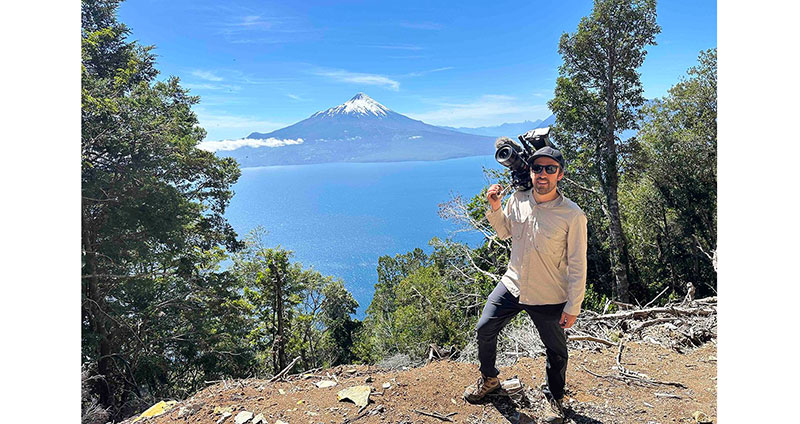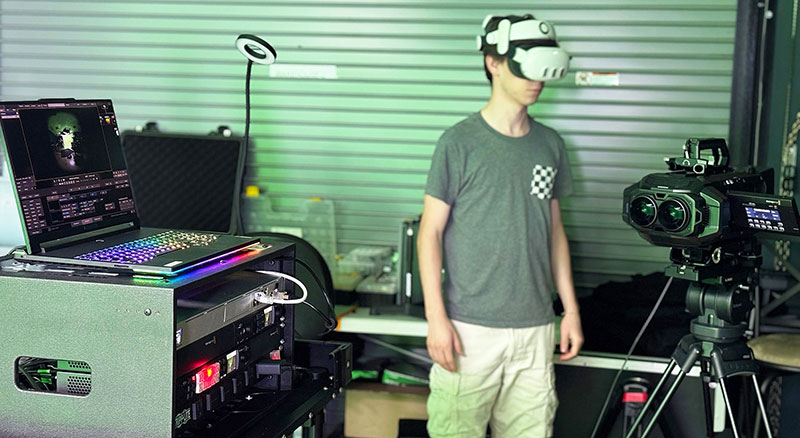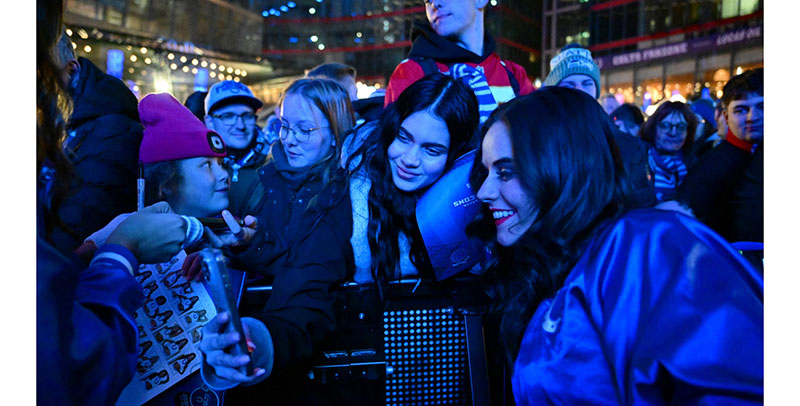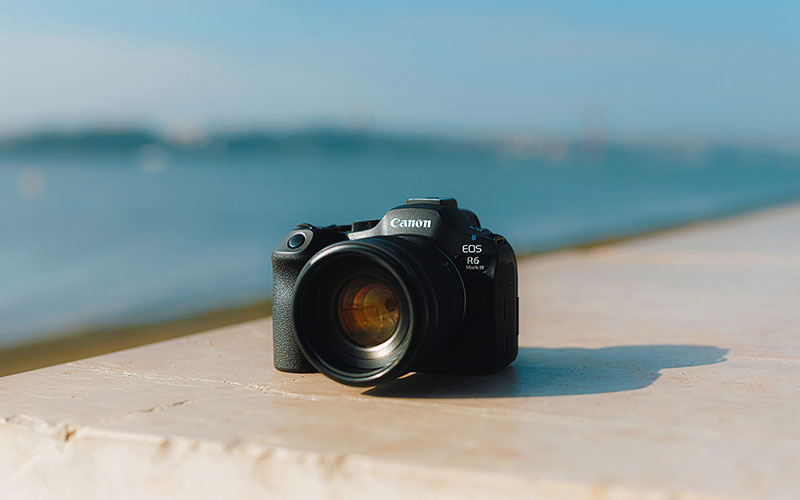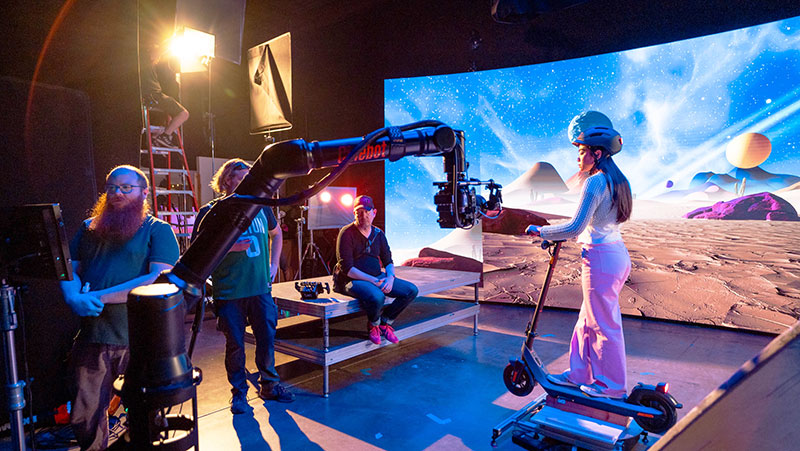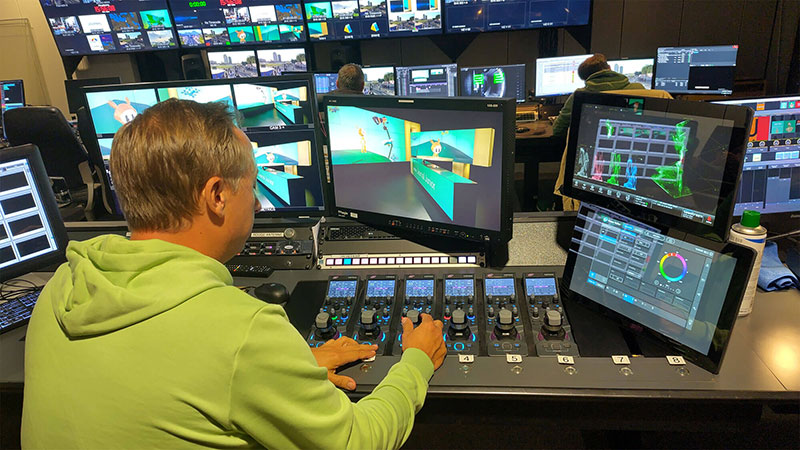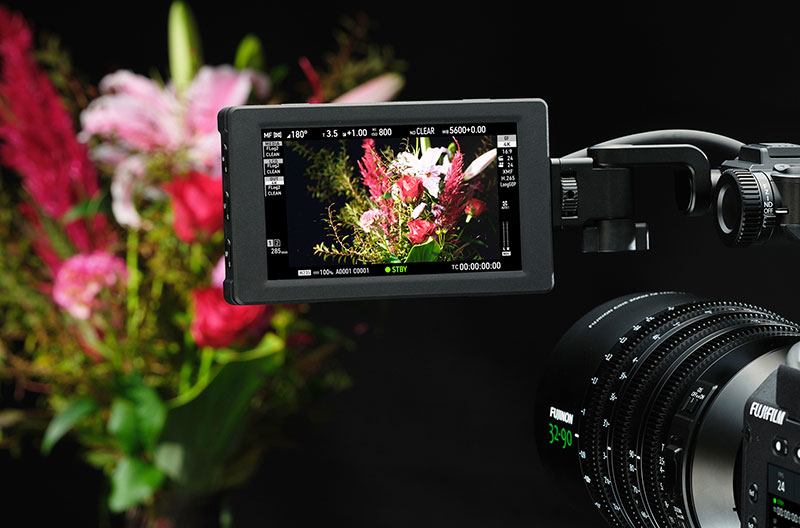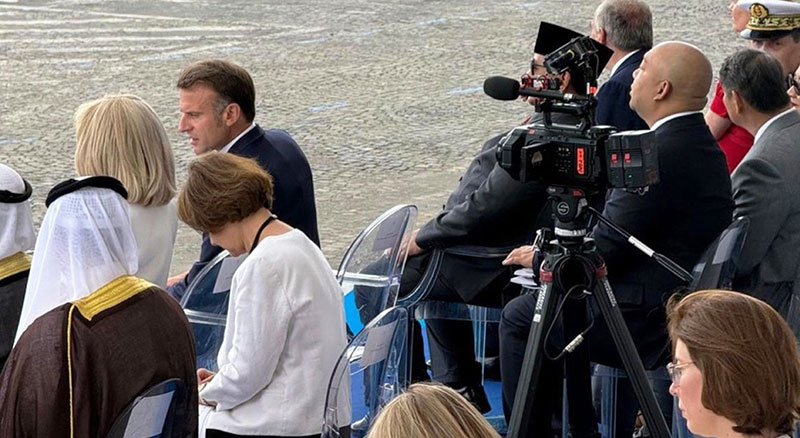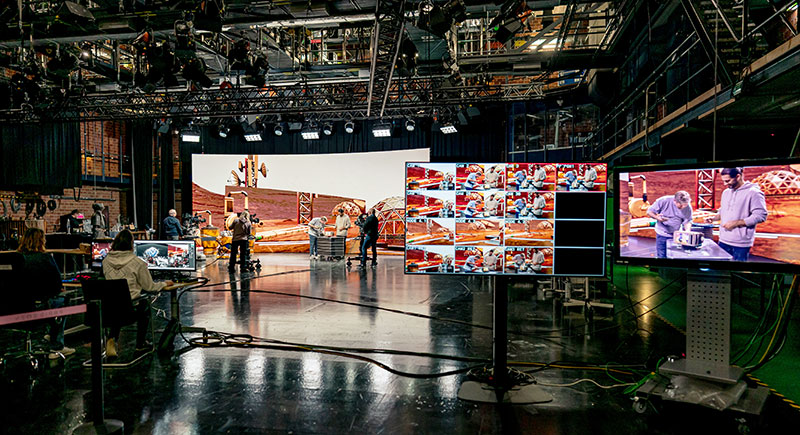Russell Crowe’s recent tour through towns in Australia and Europe was recorded with a line-up of cameras from Sony’s Cine Line, including the new ILME-FR7 PTZ model with remote controls

On a riser at the back of the venue, a crew member operates the FX6 and an FX3 on tripods at a Garden Party show.
Throughout most of his life, film actor Russell Crowe has played, performed and toured with an R&B band. The band members and touring partners come come and go, and show dates are irregular and occur at locations around the world.
Called the Indoor Garden Party, Russell Crowe’s most recent tour, which took place through most of 2023, featured 17 shows along the east coast of Australia, plus others held in Malta, Italy and the Czech Republic. The venues ranged from small pubs and clubs to large theatres and festivals including the Sydney Opera House, Australia Zoo and Karlovy Vary International Film Festival.
Expectations
One of the DoPs on the tour was Joe Machart, who talked about the expectations and preparations for the project. He said, “Russell wanted six or more cameras on every show, as well as footage of rehearsals, interviews and behind the scenes activity. Over the years my camera kit has progressed from the Sony HDR-FX1 camcorder to the NEX-FS100, the PXW-FS5 and more recently to the ILME-FX6V. When Sony announced the ILME-FR7, I was very excited to see what possibilities it would open up for us on the tour.”
Those first four cameras are compact, lightweight handheld models, but the FR7 is a pan-tilt-zoom (PTZ) camera from the Sony Cinema Line, with a full-frame image sensor and support for E-mount lenses. Helping the crew plan their work on the tour, Sony and their partner distributor Lemac organised a demo of one of the first FR7 units in Australia. They could see how camera’s focal length, shallow depth of field and remote PTZ controls would give them further creative options than they had had on earlier events.
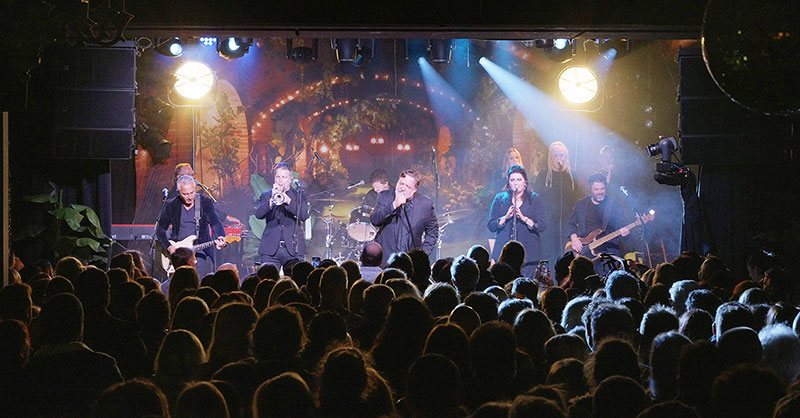
The ILME-FR7 fixed to the speaker stack at the right of the stage.
An Elegant Solution
Before the tour began, Russell Crowe hired Joe and DoP Jules O’Loughlin ACS ASC to organise the filming of two concerts he was planning at the Hoey Moey night club in Coffs Harbour. On visiting the club ahead of the shows, Joe could see that, from the audience’s point of view, it would make a fantastic live venue, which Russell wanted to capture in the footage.
“But when we discovered that our wide and mid shots at front of house would be obstructed by a low ceiling, the FR7 immediately came to mind as an elegant solution,” Joe said. “We could under-sling the camera from the lighting bar over the mosh pit. The angle from this position gave us a clear view of the stage.”
To help him on the tour, Joe worked with two old friends, cinematographers Nick Hodgskin and Scott Wood, who were both fans of the Sony Cinema Line. Joe said, “With our crew of just three people, we needed to limit the size of our gear to avoid large builds at every venue. The Sony Cinema Line was the only choice that met all of our requirements. I chose an FX6, four FX3s, three FR7s and an A7RV.”
The Look
As well as setting up shots, the cameras had to meet specific creative requirements. For example, images from all cameras needed to have a similar look so that colour correcting would be simple. Editing and post had to be done quickly while the team and camera crew were still on the road. All the cameras have S-Gamut3.Cine/S-Log3 profiles and can be matched in the grade.
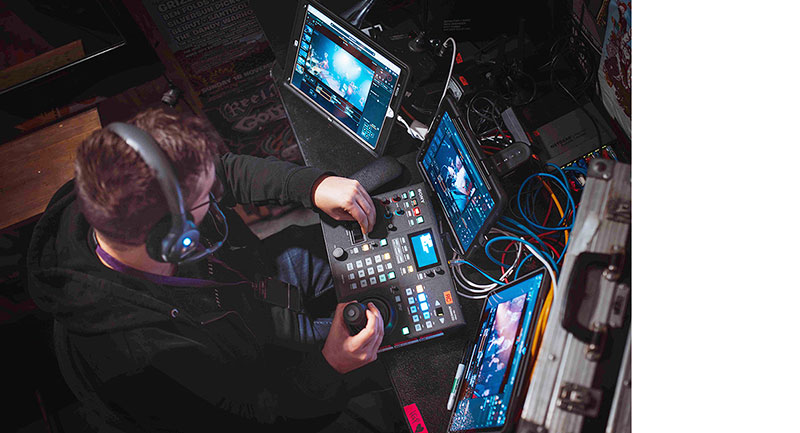
ILME-FR7 operator's desk, with three iPads for monitoring and control.
Though not quite as wide as S-Gamut3, S-Gamut3.cine/S-Log3 is among the most common and practical colour spaces used on television productions shot with the FX6 and similar Sony cameras, and is recommended for us with the most common grading software as well, such as DaVinci Resolve.
One Person, Three Cameras
“The versatility of the whole Sony Cinema Line meant that we could use each camera’s strengths to our advantage. The FX3s are extremely compact, allowing for relatively comfortable, prolonged shooting, and have in-body image stabilization for smooth movements,” said Joe. “The FX6 has ergonomic controls as well as built-in variable ND filters.
“With the camera’s high framerate options, we were capturing the emotion and energy of the performances in slow motion, and Sony’s fast, durable CF Express Type A cards were essential, as we had to manage quick turnaround times between shows. We could wrangle the data these cards onto mirrored SSDs in minimal time.”
Russell himself saw the potential of the FR7s from the early shows as a way for one person to operate three cameras simultaneously. While on tour, they set up a FR7 operator desk typically with three iPads used as touch screens to monitor and control settings, focus and move the camera. Alongside those, a Sony RM-IP500 remote controller allowed fine-tuning with a joystick and dials.
Joe said, “The ability to recall position presets and determine the speed of the movements meant we could replay shots dynamically, at the touch of a button. One person could control one camera with the RM-IP500, while also controlling a second or third camera simultaneously with presets or the iPad interface. It was a great advantage to use autofocus on a slow speed setting to rack focus between subjects on stage with just a touch on the iPad.”
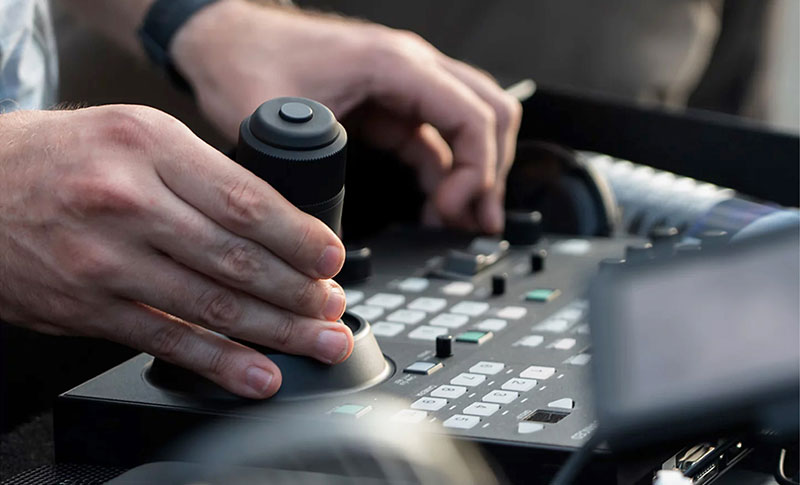
Sony RM-IP500 remote controller
Another very useful feature was the live monitoring page, which shows a full-screen live feed, but without the ability to control the camera. Joe said, “We could use our phones to wirelessly connect to the FR7 router, and remotely view a shot while setting up. We placed an iPad in Russell’s green room so that he could direct our shots, as well as see what was happening on stage.”
Stagecraft
The tour always had a Megadeck riser at the back of the room, to hold an FX6 and FX3 on tripods above the stage level. The FX3 was a locked off wide with a Sony 24-70mm SEL2470GM2 fast zoom lens, and the FX6 was a mid shot with a 100-400mm SEL100400GM, a super-telephoto zoom with high AF performance, operated by one of the crew. This telephoto lens was sometimes used with a SEL20TC teleconverter to double the focal length. The FX6 also took in left and right audio channels of the line mix from the sound desk.
“An FX6 was used to record scratch audio tracks as well on channels 3 and 4, just in case anything unexpected happened with the sound desk feed,” Joe said. “We had an FX3 on an Easyrig or DJI RS3 Pro gimbal to capture dynamic shots from within the crowd and around the stage. Russell likes movement in his shots and a feeling of being part of the audience, which these setups achieved.
“We rigged other FX3s in interesting positions using magic arms, usually on stage somewhere or at high vantage points. By using the remote control function of the Sony Creators’ App, we could put these cameras in places that aren’t usually possible to access during a show. This app meant we could access and view the shots remotely as we recorded.”
A Day in the Life
Sometimes, the crew recorded interviews with Russell for live broadcast, radio or Zoom, using the FX6 and rigging an iPad to it as teleprompter. Joe said, “In order to control latency, we either used a LiveU, cellular hotspot or Starlink dish to send and receive data in those situations, even in remote areas. the S-Cinetone picture profile worked well for these situations, producing accurate colours and cinematic skin tones.”
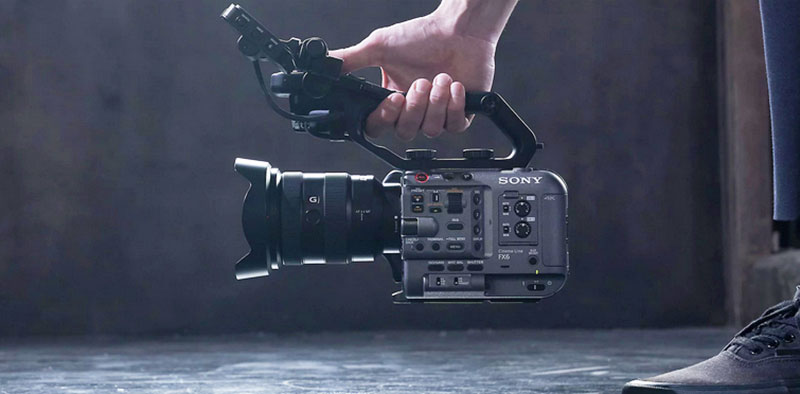
ILME-FR7
As the entire tour was to form part of an inside look at Russell Crowe’s music life, he also wanted to film rehearsals and the recording of new songs in his music studio. Musicians and their instruments filling the space didn’t leave much room for camera operators. In this situation, Joe again saw the potential of the FR7s.
He said, “We placed three FR7s around the studio and ran Ethernet cables to an operator’s desk in an adjacent room. Not only did this reduce our footprint in the room, but it also meant the musicians didn’t feel pressured by the presence of cameras. The FR7’s full frame sensor produced cinematic, shallow depth of field shots with amazing low light performance and 4K resolution.”
The Daily Routine
Joe and the crew typically started the workflow on the tour by distributing the FX6’s timecode to all of the cameras to synchronise them, and then choosing positions for their three FR7 cameras. Working with Progl+Gerlach PGX mounting plates, pecially designed for the FR7, they had numerous mounting points and a 4 mm safety rope that attached directly to the camera plate.
They also travelled with various grip gear they used to mount the FR7s in different ways. “We decided that the most versatile way to mount the FR7s at venues would be with half clamps because they gave us the option to mount the camera upright or underslung, onto existing lighting bars in venues or onto our own stands with T speed rails,” Joe said.
“We plugged the FR7s, iPads and RM-IP500 into a network switch and router. All cameras then appeared on the network and could be controlled without much setup. Over the duration of every four-hour show, none of the FR7s ever failed to respond. As each show concluded, a roaming FX3 followed the band back to the green room to capture the behind-the-scenes elements.”
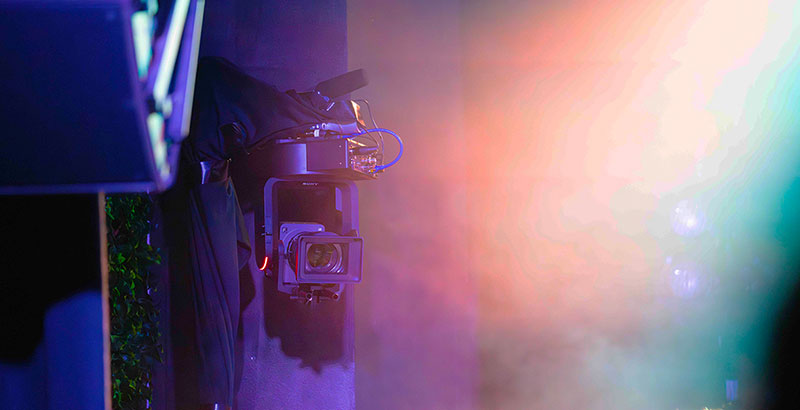
The FR7s were FR7s mounted at venues on half-clamps.
Lights, Shadows, Colours
Talking about the images themselves, Joe was especially pleased about the distinctive angles of the stage they could capture, and about the low light performance, dual base ISOs and the ECS shutter mode of the FX6 and FR7. He said, “All of these factors were crucial under the changeable stage lighting. The high dynamic range of these cameras in CineEI mode also gave us confidence that the shadows and highlights were protected. Typically, we had areas on stage with bright follow spots and other areas of deep shadows, and we wanted to preserve all these details as far as possible.”
The autofocus on the cameras gave the crew extra time, and made it possible to operate one-person gimbal setups. For example, while they concentrated on controlling the PTZ functions and composing shots, the facial recognition maintained focus on a subject’s eye, despite the constantly changing lighting and movement of the musicians.
The tour finished on a high note with a performance at the Karlovy Vary Film Festival in the Czech Republic. With the help of local production companies and crew, this show served as an apt finale, shot with 19 cameras in front of 15,000 people. pro.sony









